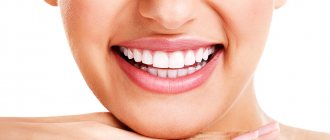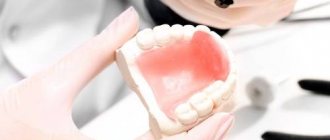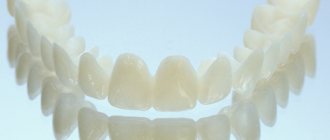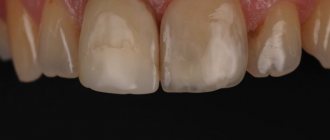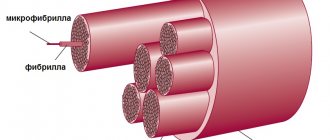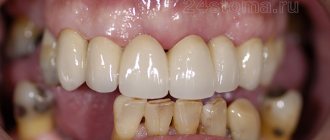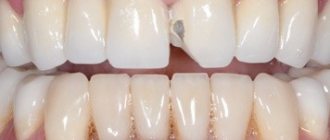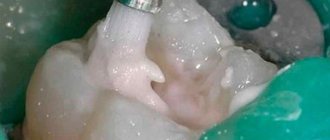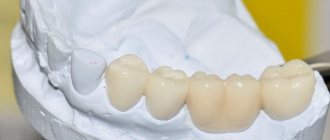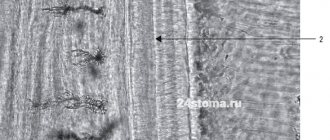Indications Installation on your teeth Materials Installation on implants What to do if the crown comes off?
How important is fixation of the tooth crown and what types of fixation are used?
In modern dentistry, preserving natural teeth is considered the most important task. For this purpose, various therapeutic and even surgical treatment methods are used. The installation of artificial crowns can be an independent method, for example, if pathological abrasion of the enamel is observed, or as part of treatment. This happens during endodontic intervention. The pulp (nerve) is removed from the tooth, it becomes brittle, and a crown is used to protect the tooth from destruction.
Indications
Indications for restoration:
- significant destruction of the coronal part;
- installation of bridges;
- pathological abrasion of enamel;
- depulpation;
- injuries.
Crowns are made of metal, ceramics and metal-ceramics. Porcelain and plastic crowns are practically not used due to their fragility. Modern materials are particularly durable and wear-resistant. They are designed for long-term use. But the service life, as well as the convenience of the crown, also depends on how well it fits and how firmly it is secured.
"President" (Italy)
Fixing cream for dentures PresiDENT (“President”) creates a dense layer under the structure that prevents particles of food mass from entering. The manufacturer assures that the effect of the product lasts throughout the day and can reach 36 hours. The absence of allergies, economical consumption, low cost (within 250 rubles) and high quality of the composition allow it to occupy a high position in the TOP of means for retaining removable structures. However, many people are faced with the fact that they cannot buy this product in all pharmacy chains.
Fixation of dental crowns
At certain stages of orthopedic treatment there is a need to use temporary crowns. In such cases, temporary fixation of crowns with special cement or artificial resin is used. The main feature of these materials is that the temporary structure can be removed without difficulty. Adhesive materials are easy to clean and leave no residue.
There are two types of permanent fixation of crowns in dentistry: cement and screw. With the development of implantology, they began to separate fixation on their teeth and on implants.
Causes of crown loss
Several factors can provoke an unpleasant situation associated with dental crowns. They depend both on the actions of the doctor and on the actions of the patient.
- Low quality materials and cement.
- Violation of the manufacturing technique of an orthopedic structure.
- Mistakes at the stage of preparation for prosthetics.
- Development of the inflammatory process under the crown.
- End of service life of the structure.
- Mechanical injury.
The permanent crown is fixed with dental cement and lasts for several years. If the doctor did everything correctly at the preparation stage, then the structure retains its tightness and strength for a long time, and it should not fall out. This can happen due to the development of caries, which appears due to irregular or improper oral hygiene. Therefore, it is so important not to skip brushing your teeth and use additional hygiene products. And also undergo professional oral hygiene at a dental clinic once every six months.
Installing a crown on your teeth
No matter how badly a tooth is damaged, as long as it has a root, it can be restored. How exactly the restoration is carried out depends on the degree of tooth decay. In case of minor damage, the unit is prepared - the top layer equal to the thickness of the crown is removed. Metal-ceramic crowns consist of 2 layers: metal and ceramic, so they require the deepest preparation. Ceramic crowns are thinner and remove a small layer of hard tissue. Zirconium crowns are thin and require minimal layer removal.
If the upper part is destroyed by 50% or more, then the crown is fixed with a pin. A fiberglass rod is inserted into the canal to serve as a support for the restoration.
Why do we need fixing agents for dentures?
Cream for dentures provides not only reliable fastening of the product in the oral cavity. At the same time it performs the following functions:
- accelerates adaptation to the design, since it eliminates chafing of the mucous membrane,
- prevents the accumulation of food masses between the product and the gums, because adheres to the mucous membrane more tightly,
- provides protection of the mucous membrane from the mechanical impact of the prosthetic structure - you will experience less pain and discomfort, both at rest and when eating,
- prevents gum inflammation (some products contain anti-inflammatory components),
- Gives freshness to your breath thanks to the additives included in the composition (not all).
Don't know what type of prosthetics to choose?
We will help in the selection, advise where to read more information and compare types of prosthetics.
Consultation with an orthopedic doctor in Moscow clinics is free! Call now or request a call
Working hours: from 9:00 to 21:00 - seven days a week
Stages
After preparing the surface, the orthopedist makes an impression of the jaws, from which a crown is stamped or cast in the laboratory. Manufacturing takes several days. Before installing the structure, they carry out fittings - check how it fits and whether there are any defects. The crown may be too wide, narrow, or high. Fitting helps to notice shortcomings and eliminate them.
The restoration is first placed with temporary cement. The patient is given the opportunity to get used to a foreign object in the mouth, to understand whether the height is disturbing or whether the edge is cutting the gum. Only after this the structure is installed on permanent cement.
- Before fixation, the crown is treated with a special solution, degreased and dried.
- Next, the tooth is treated with an antiseptic, and the remaining moisture is removed with ether or air. In some cases, gum retraction is performed with a thread to clearly mark the junction of the artificial crown and hard tissue.
- The components for cement are mixed on a sterile plate.
- A thin layer of cement is placed inside the restoration and placed over the tooth.
- Excess is removed. The patient is asked to sit with his teeth closed. Then clean the surfaces again and rinse your mouth with a special solution. This completes the orthopedist’s work.
Fixing cream "Protefix"
A German-made product with a dense consistency and easy application. It has a number of important advantages:
- ease of application due to high viscosity;
- absence of harmful chemical components, dyes and fragrances in the composition;
- does not change the taste of food and drinks;
- economical use of funds;
- guaranteed stable fixation for 12 hours;
- immunity to salivation;
- fast adhesion time - it only takes 5 minutes to secure the prosthesis in the mouth;
- antiseptic effect.
The drug has almost no contraindications and can be used for both permanent removable systems and temporary ones.
Materials for fixing crowns
Cement for fastening restorations must perform 2 main functions: securely fix the crown and fill the microgaps between it and the dentin. Several types of fixing materials are used in dentistry:
- Glass ionomer cements
(GIC). They are good because they have anti-caries properties and are not afraid of micro-leaks. Used for structures made of metal, with a metal base and ceramic. - Glass ionomer cements modified with composite
(GICMC). Easy to use and very durable, such materials are used for restorations made of metal, zirconium, and lithium disilicate. - Composite
. The most modern materials. They produce cements that harden as a result of a chemical reaction, light radiation and double curing. Suitable for fixing metal-ceramic, zirconium, ceramic, and lithium disilicate crowns.
All these groups are divided into numerous subgroups and the doctor selects the material for fastening based on the geometry of the tooth, crown material, and clinical case.
Dental cements have been used for a long time, they are well studied, application methods have been worked out and are simple in nature. These materials reliably fix restorations and can serve for a long time.
The disadvantages of cements are that mixing is done by hand and errors in proportions are possible. This leads to de-cementing. Excess acids negatively affect the condition of dentin.
Cream "Korega" for dentures
One of the leaders in the fixing agents market. The line consists of 3 types:
- extra strong mint;
- neutral;
- refreshing.
According to data, it ensures fixation of a removable denture throughout the whole day. It comes with mint or neutral flavor. The cream does not contain zinc, so it can be used on an ongoing basis.
How to apply cream
Fixing cream for dentures "Korega" is applied in strips to the inside of the previously cleaned insert structure. It is also necessary to rinse your mouth to remove any remaining food.
After pressing the prosthesis to the gums, the product should not enter the oral cavity. After attaching the structure, it is not recommended to immediately start eating. For strong fixation, you need to wait 10-15 minutes.
Removing the prosthesis
Corega glue reliably fixes dentures, so it is possible that you will need to remove the structure yourself at the end of the day. It's easy to do:
- First you need to rinse your mouth with warm water.
- Then, using rocking movements, try to remove the denture from the oral cavity.
- If it is still fixed, you need to lightly press on the gum mucosa from the cheeks and remove the denture.
- After removing the denture from the oral cavity, it should be thoroughly rinsed using special products recommended by the manufacturer of the fixing cream.
Prosthetics on implants
Crowns are secured to implants in 2 ways: with cement or a screw
. This depends, first of all, on the type of implantation and the implant models that are used. But anatomical features and clinical manifestations play a big role.
Cement fixation of crowns on implants has its pros and cons. The process of attaching a restoration to an implant using cement is not much different from prosthetics on natural teeth. It is simple, well studied, and allows fixation in complex cases where a screw fixation would require enormous effort and skill.
The disadvantages include the possibility of peri-implantitis, which can be caused by excess cement. When using cement, the crown cannot be repaired, only replaced.
Screw fixation of crowns to the implant prevents cement from getting on the tissue. There is a possibility of repair and correction. The results of joining metal to metal without a cement layer are better. The single design of abutment and crown reduces the risk of infection.
However, the fitting of a screw-fixed prosthesis is more delicate, requires certain skills, and the price of designs with screws is higher.
This is why choosing a doctor is so important. A qualified implantologist takes into account dozens of details before choosing an implantation method, which determines whether the crown will be screw-fixed or cemented, and an experienced orthopedist knows how to work with both.
Adverse reactions
The best cream for fixing dentures should not only be effective, but also not give adverse reactions even with long-term use. In case of an overdose of the drug, the following symptoms may occur:
- increased salivation;
- nausea, possible vomiting;
- general malaise;
- allergic reactions.
If you notice such manifestations, immediately visit your dentist: he will help you choose a remedy that will not cause unwanted reactions.
How to use the composition correctly
Fixation cream must be used according to the instructions. The general rules are the following:
- the product is applied to the prosthesis from the inside, only on the lines intended for this purpose and in a small amount (if there is a lot of it, the fixation strength weakens). The recommended volume is usually indicated in the instructions, and the most optimal for a particular person is established experimentally,
- strong creams for dentures containing zinc should not be applied more than once a day - the risk of neurological disorders increases,
- the structure must be clean: before applying the fixing composition, it should be washed with warm water (if necessary, ordinary soap can be used) and wiped dry with a lint-free cloth,
- After removing the removable denture, the fixing cream must be removed: to clean the structure from residual composition, use a toothbrush with extra soft bristles and toothpaste intended for small children (due to their low abrasiveness, such pastes do not damage the surface of the product).
On a note! If, when removing the structure before going to bed, it turns out that it is securely fastened, it is permissible to leave it until the morning. Next time, the amount of composition applied should be reduced.
Corega (Ireland)
Cream for dentures Corega (“Corega”), along with positive reviews, has quite a lot of negative ones. Among the advantages are an affordable price (about 250 rubles), economical consumption, and the possibility of use for sensitive gums. Its use does not require preliminary drying of the structure. The negative aspects include the rapid dissolution of the product under the influence of water, which leads to a short period of operation - only 3-4 hours. The same property provokes the entry of the composition into the digestive tract during food intake.
"Protefix" (Germany)
Among the positive properties of the popular cream for fixing dentures, Protefix (“Protefix”), we can note: economical consumption, excellent adhesion, dense structure that limits the penetration of food. The manufacturer has released three types of “Protefix”: without coloring and aromatic components (suitable for allergy sufferers), with mint, and with aloe. The product deservedly receives positive reviews from users due to its affordable price (about 200 rubles) and the possibility of use for increased sensitivity of the mucous membrane. Among the disadvantages, users note the inconvenience of the dispenser and the weakening of the fixation under the influence of hot food.
